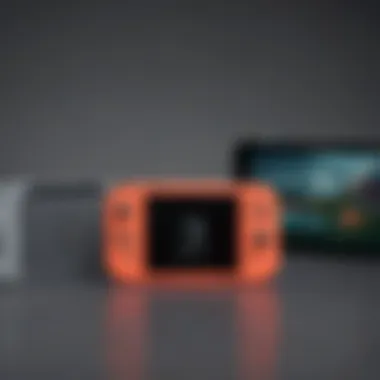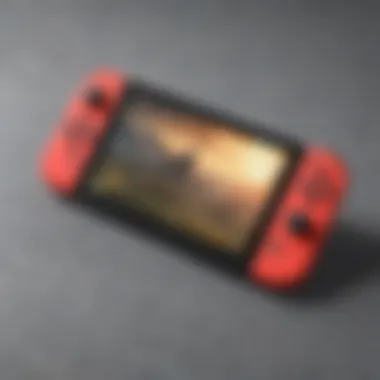Key Differences Between Nintendo Switch and Switch Lite


Intro
The gaming world continues to grow rapidly, especially with devices focusing on portable entertainment. Among these devices, Nintendo Switch and Switch Lite serve unique purposes yet hold a strong place in players’ hearts. Knowing the distinct features of each can greatly enhance one’s gaming experience.
This article examines these differences, diving deep into design, functionality, game compatibility, and the target audience. As we dissect this topic, potential buyers and enthusiasts will find pertinent insights that will support their choices in Nintendo's gaming landscape. Understanding these aspects can bridge the gap between choosing one system over the other.
Game Reviews
Overview
These two consoles are not just different in labels; they cater to different gaming lifestyles. While Nintendo Switch serves as a versatile device playable at home and on the go, Switch Lite leans entirely towards portability, offering a refined experience.
Gameplay
In terms of gameplay, each console provides its attributes. Nintendo Switch presents a hybrid gaming experience with its ability to connect to a dock and transition seamlessly between handheld and console modes, making it inherently versatile. Switch Lite, on the other hand, is designed exclusively for handheld gaming, engaging players on the move.
Storyline
While both devices play the same games, storylines depend more on individual games and not the console itself. Popular titles, such as The Legend of Zelda: Breath of the Wild or Animal Crossing: New Horizons, maintain equal narrative depth regardless of the device.
Graphics
Graphics journey back to the power of the console itself. Nintendo Switch displays games in 720p in handheld mode and up to 1080p in docked mode. But Switch Lite only plays in handheld mode and shares this graphics capacity. However, nuances in performance settings for individual games may create discrepancies in graphical presentations.
Soundtrack
Sound quality on both systems remains high. However, the usage of external equipment may create variation. While Switch can connect to TVs and sound systems for improved audio experiences, Switch Lite uses built-in speakers and headphones.
Pros & Cons
- Nintendo Switch
Pros:Cons: - Switch Lite
Pros:Cons:
- Hybrid functionality with dock usability.
- Wider game library.
- Better for multiplayer experiences with detachable Joy-Cons.
- Heavier than Switch Lite.
- Costs more than its lightweight counterpart.
- More portable and lighter than the Switch.
- More affordable option for gamers on a budget.
- Limited to handheld mode.
- Lacks connectivity for TV gaming.
Final Verdict
Choosing between these consoles involves reflections on players' gaming preferences. Nintendo Switch, with its versatility, attracts a diverse range of gamers, while the Switch Lite appeals to those who prioritize accessibility and a lowered price. Understanding these elements facilitates a deeper connection with devices and ultimately influences gameplay experience.
Intro
The evolving landscape of video gaming significantly highlights the importance of understanding the differences between talking Systems placed prominently by industry leaders. Nintendo has long been a name synonymous with innovation, particularly in the realm of portable gaming consoles. The introduction of the Nintendo Switch and Switch Lite signifies an evolution that caters to diverse gaming preferences. This article aims to clarify distinct aspects of these systems, ensuring that readers can make informed and savvy decisions. Each section delves into critical areas, such as design nuances and functional capabilities, presenting a fine-tuned comparison.


The Rise of Nintendo's Portable Consoles
Nintendo has a storied history when it comes to portable gaming. From the Game Boy series that introduced portable gaming to millions, to the DS and the 3DS models adored by enthusiastic gamers, each iteration carved its place in gaming evolution. The market always favored devices that not only entertained but offered versatility. To this end, the introduction of the Nintendo Switch captured both casual and high-end gamers alike, transforming conventional gaming via hybrid functionality. With the Switch Lite aimed at those who prefer a more handheld experience, Nintendo's strategy reflects ongoing consumer demand for versatility, ensuring their devices meet diverse player needs.
Overview of Nintendo Switch and Switch Lite
The Nintendo Switch stands out for its hybrid capabilities, allowing users to seamlessly transition between handheld and console gaming formats. It is often recognized for its detachable Joy-Con controllers and a myriad of features that heighten the gaming experience. Alternatively, the Switch Lite shines as a dedicated handheld console, tailored for those seeking simplicity without the more expansive options provided by its larger counterpart. Each device serves specific functions:
- Nintendo Switch: Perfect for shared play, flexibility of use, home setting.
- Nintendo Switch Lite: Suitable for on-the-go gaming, straightforward usage, and accessibility.
Today’s gaming audience desires different solutions merging style and functionality. Thus, understanding these differences not just enhances personal choice, but also aligns with consumer behavior in an expanding market.
Design Comparison
Design plays a critical role in evaluating any gaming console. For those considering either the Nintendo Switch or the Switch Lite, understanding the fundamental differences in design can influence decisions. Crucial elements such as size, weight, screen quality, and aesthetic options are vital to user experience. A portable console's design not only affects functionality but also impacts ease of use, comfort during long gaming sessions, and suitability for various gaming conditions.
Size and Weight
When it comes to size and weight, the Nintendo Switch and Switch Lite diverge significantly. The Nintendo Switch measures approximately 9.4 inches by 4 inches, while the Switch Lite is slightly smaller at 8.2 inches by 3.6 inches. This size difference peaks in how each device feels in hand; the Switch Lite is generally more compact and lighter at around 0.61 lbs compared to the Switch's 0.88 lbs.
For many users, the lightweight build of the Switch Lite enhances its portability, perfect for travel or on-the-go gaming. However, the larger Switch may appeal to users who prefer a more substantial feel, providing better stability when playing in tabletop mode.
Ultimately, whether one values compactness over robustness could sway your choice for either console.
Screen and Display Quality
Next, let’s examine the screens of both consoles. The Nintendo Switch sports a 6.2-inch LCD display with a resolution of 1280 x 720 pixels. In comparison, the Switch Lite houses a smaller 5.5-inch LCD display at the same resolution. The screen on both devices provides vibrant colors and clear images; however, the larger display of the Switch may better capture details in more graphically demanding games.
Color Options and Customization
Color options and customization also enter the design comparison. The Nintendo Switch often comes in a range of color options, such as Neon Blue and Neon Red or just a clean black docked unit, making it versatile for a variety of tastes. Contrasting, the Switch Lite shines with its vibrant pastel selections including yellow, turquoise, and coral.
While neither console offers extensive customization features, the colorful designs of the Switch Lite root it in accessibility for younger audiences or those who enjoy lighter aesthetics. The Nintendo Switch, however, extends possibilities further with its game design and Dock station color. Choosing between them may ultimately rely on personal preference for subtlety versus extrovert designs.
“Design choices allow for personalization and highlight individual gaming style.”
Whether one opts for portability with the Switch Lite or a more substantial gaming experience with the Nintendo Switch, these design considerations shape the essence of gaming preferences and habits.
Play Modes: Handheld vs.
Untethered
Nintendo Switch is designed for versatility. It allows players to switch between handheld and docked modes, giving the player the flexibility to enjoy games on a larger TV screen or on the go. When docked, the experience expands sharply – different game modes unlock new ways to play. In contrast, the Switch Lite is strictly a handheld device. It lacks the docking capability, meaning it's confined to portable play alone. This difference can affect gaming preferences considerably, particularly for those seeking multiplayer experiences or immersive play on a larger display.
It’s worth noting that > the Switch Lite can only be used in handheld mode, which eliminates the option of sharing the screen for party play. This fact can deter those drawn to cooperative games that Thrives with local thumb sticks swapping.
Battery Life and Performance
Battery life is a significant aspect in a handheld gaming console. The Nintendo Switch approximately offers between four and ten hours of battery life, largely depending on the games and usage. Conversely, the Switch Lite benefits from longer battery life, generally stretching from four to seven hours due to its simplified design and lack of additional functionalities that drains power.


Performance is another crucial point. While both devices share similar processing capabilities, demanding games might perform better on the Switch. This could overpower any slight advantages the Lite has in battery longevity. Therefore, analyzing typical play styles can assist in clarifying which device suits one’s needs more appropriately.
Controller Attachment and Features
The Nintendo Switch provides the unique advantage of Joy-Con controllers. The ability to detach Joy-Cons adds flexibility for local multiplayer games. Each Joy-Con is equipped with motion sensors, offering rich interactive gameplay opportunities that are not present in its Lite counterpart. Moreover, the Switch is compatible with several accessories that enhance play, influenced by immersive games like Super Smash Bros. Ultimate or Mario Kart 8 Deluxe.
Combined, these elements accentuate the Zelda or Mario experience while steering preferences towards one device over the other.
Game Compatibility
In the realm of video games, compatibility with existing and future titles significantly shapes a console's appeal. For anyone considering the Nintendo Switch or Switch Lite, understanding game compatibility is crucial. This dimension entails not just the available game library but also how specific consoles function with both new and old titles.
Some crucial factors include:
- Available Game Library: The Nintendo Switch boasts a substantial collection of games that caters to diverse gaming preferences.
- Performance Variability: How games perform on each device can influence the overall enjoyment and gameplay experience.
- Exclusive Titles: Certain games are platform-exclusive, which can be a deciding factor for console choice.
Investing in a console also concerns future-proofing against a rapidly evolving gaming environment that often favors versatile compatibility.
Game Library Overview
The range of games accessible is one of the vital differentiators between the Nintendo Switch and Switch Lite. Ordinarily, the Switch supports the largest selection of titles in the Nintendo ecosystem. Popular games like The Legend of Zelda: Breath of the Wild, Super Mario Odyssey, and Animal Crossing: New Horizons can be played on this platform. In contrast, the Switch Lite omits some remote functionalities.
Here are some key points regarding the game libraries:
- Main Console (Switch): Full access to all Nintendo and indie games, often optimized for dual-screen or tabletop play.
- Switch Lite: Carries a solid collection but may need careful consideration for multiplayer games that utilize additional controllers or console features.
- Future Releases: Both devices will continue to see game releases, yet it is important to keep in mind that not all upcoming kids or limited-headed titles will work on the Lite version.
Although the Switch Lite provides corrospondences for game players, prospective purchasers may want to confirm that critical games they hope to play are not exclusively applicable to the traditional Switch. Purchasers foreseeing significant multiplayer usages could get unease with the lack of TV outs.
Exclusives and Limitations of Switch Lite
When identifying the capabilities of the Nintendo Switch Lite, it’s necessary to outline both its game compatibilities and limitations. The device is designed solely as a handheld console, so it has specifications targeted toward that gameplay style.
Key elements affecting exclusives and limitations include:
- No Docking Functionality: Since the Switch Lite lacks a dock, users cannot connect it to a television for widescreen play. Esteemed viewing options, especially for shared experiences, are unavailable here.
- Limited Controller Compatibility: Physical gaming accessories need separate considerations. Multiplayer, couch-based or additional controlers for games requiring splitscreen may necessitate external purchases.
- Exclusivity Caveat: Some games insist on or benefit from the additional features of Joy-Cons, which the Switch Lite cannot utilize directly.
- Indie Games And Portabel Titles: Most of it still active, but ones emphasizing multi-use properties could barely-afford-up proportions to play here compared to their basic releases.
The restrictions may be acceptable for fans looking for portability rather than versatile features. Others may not view the Switch Lite favorably due to its fewer capabilities.
"The mode of gameplay often dictates the timeframe of satisfaction. Assessing yourself against exclusive content and functions will lead to more informed contents separately within."
In this light, choosing between devices requires careful consideration both of what you'd like to use your console for and how you prefer to game generally.
Target Audience
Understanding the target audience for the Nintendo Switch and Switch Lite is critical for grasping the nuances between these two consoles. Each device has its distinct appeal and functionality, aligning themselves with different types of gamers. Knowing this helps buyers make informed decisions, whether they lean towards casual gaming or aim for a more involved experience.
Casual Gamers vs.
Hardcore Enthusiasts


Casual gamers typically seek simplicity and accessibility in their gaming experiences. They favor devices that require minimal setup and can be enjoyed during short gaming sessions. The Nintendo Switch caters well to this group due to its hybrid nature—allowing users to play both with friends in multiplayer mode or alone in handheld mode. In contrast, hardcore enthusiasts often possess a deeper commitment to gaming, seeking richer experiences, extensive game catalogs, and potential for pro-level play. While the Switch offers advanced features to keep these players engaged, the more limited game accessibility of the Switch Lite may not suit their high expectations.
Thus, the device choice often varies with time, motivation, and gaming intensity priorities.
Affordability and Value Proposition
Pricing plays a significant role in the target audience's decision-making process. The Nintendo Switch Lite provides an opportunity for affordability. It typically appeals to families, younger audiences, and casual gamers unwilling to invest significantly in their equipment. Although it offers many Switch game compatibility options, the Lite does not accommodate dock-based mode, limiting social play on larger screens. In contrast, the full Nintendo Switch is positioned as a premium gaming device with its added functionalities at a higher price point.
This variance can lead buyers to evaluate their expectations versus price. Are they interested in a flexible, hybrid console, or is a simpler, more straightforward portable device more in line with their gaming habits? The public perception tied to each option corresponds directly with their pricing structures, leading to broader discussions about accessibility in gaming.
In the end, discerning the target audience facilitates important quite resonation with product offerings and fosters an ecosystem that understands diverging needs and preferences.
Pricing and Availability
Pricing and availability are crucial elements to consider when comparing the Nintendo Switch and Switch Lite. Knowing how the price influences among consumers helps to understand market positioning and buyer satisfaction. Often, price reflects not only the features but also the anticipated economic reach of each console. By dissecting pricing structures and market trends, we get a pointed view of how both consoles meet different demands. This analysis is especially relevant for gamers and budget-conscious consumers, aiding in making more informed choices.
Retail Pricing Structures
The retail pricing structures of Nintendo Switch and Switch Lite greatly influence their accessibility. The Nintendo Switch, typically priced at a higher rate, often ranges around $299. It supports a versatile gaming experience, catering to both handheld and docked play. In contrast, the Switch Lite starts approximately at $199, designed for more casual use, specifically focused on handheld play. Those prices represent a fundamental aspect for potential buyers. Here are some distinct cost factors:
- Initial Investment: The price you pay upfront influences not only your immediate decision but your permit buying capacity later on.
- Discounts and Sales Events: Companies may initiate pricing adjustments during specific events or sales, increasing affordability.
- Accessories: Depending on which model you choose, anticipated costs of accessories like controllers may vary significantly, affecting overall spending.
Choosing a console does not just involve its purchase but also requires consideration of follow-up costs based on accessories and games.
Market Trends and Availability
Market trends impact significantly on consumers' ability to purchase either console. As gaming cycles and preferences change, Nintendo adapts its strategies accordingly. The Nintendo Switch had an immense launch, enjoying preferred consumer status. Supply shortages can sometimes affect the availability of both consoles. Here are some important insights:
- Stock Levels: Available stock can fluctuate based on demand and seasonal influences like holidays. Understanding supply forecasts helps buyers plan purchases better.
- Second-Hand Market: While both consoles may decline in price over time, the pre-owned market remains substantial. Buyers may find lucrative deals through trusts with printional guides.
- Regional Availability: Different regions might experience varied impacts on purchasing prices or local market scenarios. It becomes necessary to check localized statistics to ensure best decisions.
In summary, considering the pricing and availability can play a defining role in guiding the decision-making process when it comes down to choosing between these two gaming consoles.
Epilogue
The concluding section of this article is essential as it synthesizes the information presented and distills the key findings regarding the Nintendo Switch and Switch Lite. Understanding the distinctions between these two consoles can lead to an informed choice for prospective buyers. The importance of evaluating factors like design, functionality, and game compatibility cannot be overstated for someone looking to invest in a console.
Summing Up the Differences
In summary, the Nintendo Switch and the Switch Lite each cater to different gaming preferences and circumstances. While both share the Nintendo gaming ecosystem, they offer distinct experiences. The Switch is more versatile with features suited for both handheld and docked play, while the Switch Lite focuses solely on handheld gaming, offering a more compact design.
Some important differences include:
- Play Modes: The Switch appeals to gamers who prefer flexibility, while the Switch Lite is dedicated to handheld usage.
- Controller Capability: Switch supports removable controllers, providing multiplayer options on-the-go, while Switch Lite's controllers are integrated.
- Game Library compatibility: Both devices can access a wide array, but titles that require Joy-Cons specifically won’t function on the Switch Lite.
This articulation of differences sets the foundation for gamers to evaluate their preferences effectively. The reader should feel equipped with a broader perspective on both consoles.
Making the Right Choice
Choosing between the Nintendo Switch and Switch Lite is ultimately a decision driven by individual gaming styles and needs. The Switch is recommended for users who value versatility; it is also ideal for co-op play. It encourages interactive experiences, appealing to a more communal gaming spirit.
In contrast, the Switch Lite is for those who enjoy gaming on-the-go, offering a dignified solution at a more approachable price. Considerations are needed not just around cost, but personal gaming habits: regular couch sessions versus sporadic travel play could sway the choice significantly.
Additionally, potential buyers should explore their game preferences. If the gaming experience extends beyond single-player and handheld modes, the Switch could be worth the investment. Both consoles have a faithful user base confirming their unique benefits.
Ultimately, the right choice hinges on ensuring the console aligns well with your lifestyle and gaming habits. Reflect critically on your preferences, assess the features laid out, and make the best informed choice for robust gaming enjoyment.



